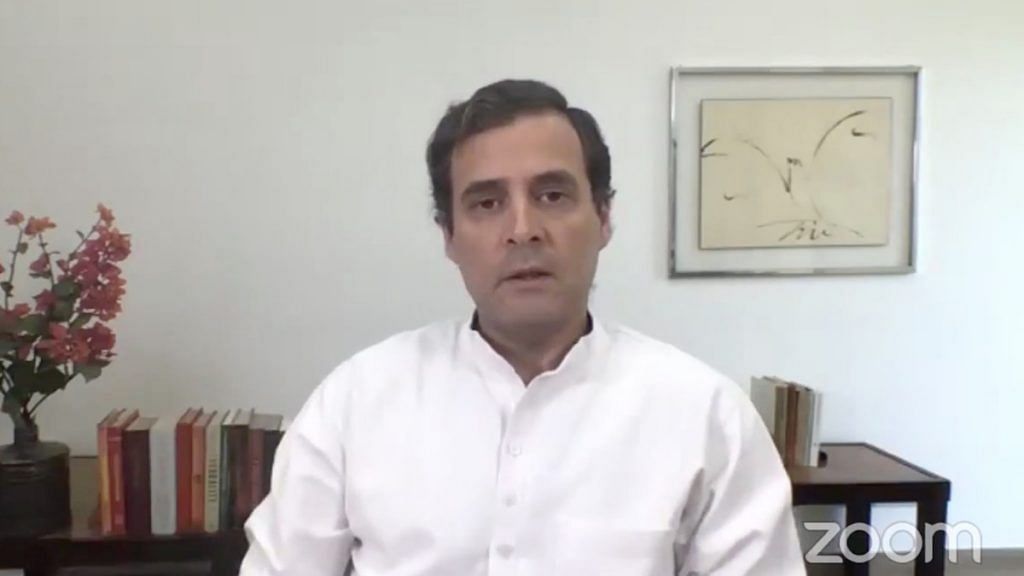New Delhi: Congress leader Rahul Gandhi stepped out of his 12, Tughlak Lane residence after months Monday afternoon to meet his mother and the party’s interim president Sonia Gandhi, soon after concluding a meeting with rebel leader Sachin Pilot.
This is the first time since May that the Gandhi scion has been spotted in public, and it would’ve been blink-and-you-miss-it had it not been for the cameras outside his house.
Back on 16 May, Rahul Gandhi was spotted interacting with migrant workers near Delhi’s Sukhdev Vihar flyover.
Delhi: Congress leader Rahul Gandhi interacted with migrant labourers who were walking near Sukhdev Vihar flyover to return to their home states. Party volunteers later arranged vehicles to take them to their homes. A labourer, Monu says “Coming from Haryana,have to go to Jhansi” pic.twitter.com/SMbnejiZpK
— ANI (@ANI) May 16, 2020
This strategy has been the polar opposite of that employed by BJP leaders in general, and PM Narendra Modi and Home Minister Amit Shah in particular.
PM Modi has attended various events in the last two months, from the Ram Mandri bhoomi pujan ceremony in Ayodhya on 5 August, to his visit to Leh on 3 July, as well multiple cabinet meetings.
Shah, who tested positive for Covid-19 on 3 August, had participated in a cabinet meeting days before. Before that, in July, he had visited a new Covid-19 hospital with Defence Minister Rajnath Singh and Delhi CM Arvind Kejriwal.
Also read: To beard or not to beard — Modi and Rahul Gandhi’s makeovers mirror their politics
Increased online presence
Gandhi has significantly increased his social media activity since the Covid-19 pandemic hit. Starting in April, Gandhi has held video interactions with multiple health and economy experts on the subject of the novel coronavirus as well as the impact of the lockdown, such as economists Raghuram Rajan and Abhijit Banerjee, health experts Ashish Jha and Johan Giesecke, industrialist Rajiv Bajaj, and most recently, Nobel laureate economist Muhammad Yunus.
In the last week of June, Gandhi also joined Telegram, the Russian instant messaging app, in a bid to make his presence felt across online platforms. Then, in July, he started a video series aimed at countering the “hate-filled narrative” spread by the news media, wherein he shares his thoughts on “current affairs, history and crisis”.
The three episodes released so far have all been about the India-China stand-off and the Narendra Modi government’s response to it.
Flaw in Rahul Gandhi’s strategy
However, the videos and his interviews have failed to reach a large audience. Gandhi’s team has conceded that the project is supposed to be ‘niche’ and not have mass appeal.
Following his interaction with the migrant labourers in May, he raised their issues on social media, as well as in his online conversations with experts. But political analysts say that isn’t enough to maintain visibility and prominence in the minds of the people.
“His interaction with migrants was a good start, but should have been followed by other such events. The poor migrants, whose issues Rahul Gandhi raises on Twitter, aren’t present on Twitter. Political issues are made by consistent focus, and ground-level events, that crystallise your position on the issue in the public consciousness,” said Asim Ali, research associate at the Centre for Policy Research.
Ali added that the pandemic cannot be used as an excuse to suspend ground-level politics.
“In a country where ordinary men and women go out daily, risking their lives to earn a living, it is a weak excuse to hide behind health risks. It is not enough to have the right issues; it is about whether you reach out to people with those issues,” he said.
“The video interviews were meant to contrast an arrogant Modi with a humble Rahul Gandhi. But they reached only a sliver of the population. People are not looking for educational guidance from their political opposition, but a willingness to fight for them,” Ali said.
Ali added that Gandhi could have made the contrast more evident by “listening intently to ordinary people than to the esoteric lectures of academics in English”.
Also read: SP, BJP, Congress — A guide to how Rahul Gandhi can renew aging party
‘Raised pertinent issues without risking public health’
The Congress, meanwhile, maintains that Rahul Gandhi has raised all the “pertinent” issues without putting public health and safety at risk.
“A true comparative analysis should not see how many times a leader is seen within the camera frame but what issues he raises and with what gravitas,” said Jaiveer Shergil, spokesperson for the Congress.
“He (Rahul Gandhi) has raised the issue of China’s occupation of Indian territory, the rising coronavirus cases, and the migrant crisis consistently via his online presence. Meanwhile, the PM, despite his boots-on-the-ground approach, has conveniently ignored both the crises,” he said.
Besides his online interactions with experts, Gandhi has also held various internal Congress party meetings in the last three months on Zoom — such as one with the party’s Bihar unit last week, and one with leaders of the student wing, NSUI, last month.
We thank Shri @RahulGandhi ji and Shri @kcvenugopalmp ji for taking out the time to attend NSUI National Office Bearers' meeting and giving us valuable guidance on the way forward.
1/2 pic.twitter.com/TX2FFsrFN9— NSUI (@nsui) July 15, 2020
“He has been able to solve the crisis in Rajasthan, and has kept a close watch on Bihar. He has prioritised public safety, while also focusing on work,” Shergil said.
Also read: Rahul Gandhi and Congress party can strike a fine balance in taking on Narendra Modi
